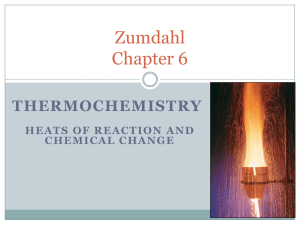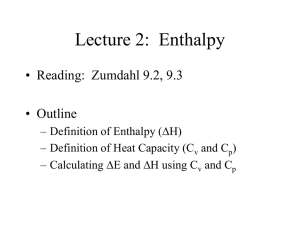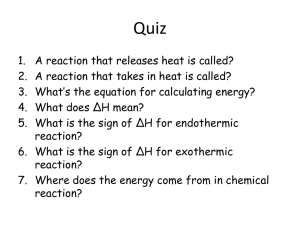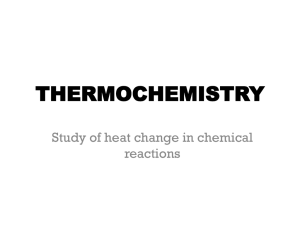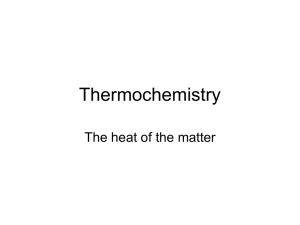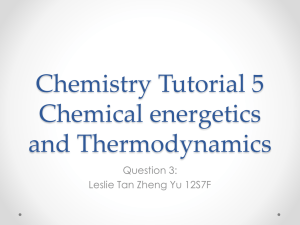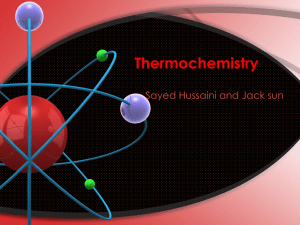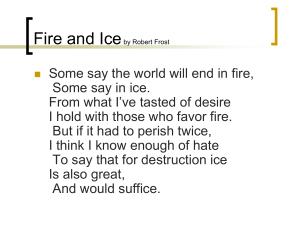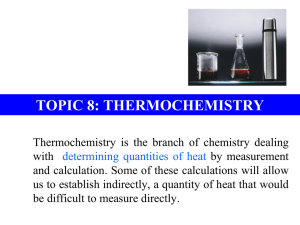Document
advertisement
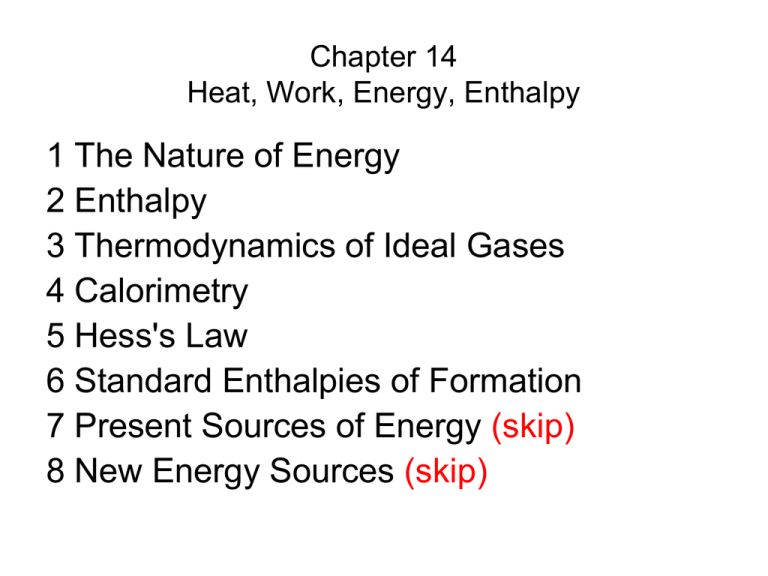
Chapter 14 Heat, Work, Energy, Enthalpy 1 The Nature of Energy 2 Enthalpy 3 Thermodynamics of Ideal Gases 4 Calorimetry 5 Hess's Law 6 Standard Enthalpies of Formation 7 Present Sources of Energy (skip) 8 New Energy Sources (skip) James Prescott Joule (1818-1889) Highlights – English physicist and !!brewer!! – Studied the nature of heat, and discovered its relationship to mechanical work – Challenged the "caloric theory”l that heat cannot be created nor destroyed. – Led to the theory of conservation of energy, which led to the development of the first law of thermodynamics – Worked with Lord Kelvin to develop the absolute scale of temperature – Pupil of John Dalton (Atomic Theory) – Joule effect: found the relationship between the flow of current through a resistance and the heat dissipated, now called Joule's law Moments in a Life (Death) – Gravestone is inscribed with the number “772.55” the amount of work, in ft lb, he determined experimentally to be required to raise the temperature of 1 lb of water by 1° Fahrenheit. “772.55” Thermite Reaction Reactants → Products 2 Al (s) + Fe2O3 (s) → Al2O3 (s) + 2Fe (s) Energy • Definition of Energy: Capacity to do work. • The study of energy and its interconversions is called Thermodynamics. • 1St Law of Thermodynamics: Conservation of energy. – Energy can be converted from one form to another but cannot be created of destroyed. – The energy of the universe is constant. – The energy of a closed system is constant. – Heat and work are interconvertable Forms of Energy • • • • • • Chemical Energy Potential energy (e.g., ΔEpotential= mgΔh) Kinetic energy (e.g., ΔEKinetic= Δ (1/2mv2) Electrical Energy Nuclear Energy • Energy transfer – Through heat – Through work Energy • Energy is a state property, which means it depends on the initial and final state, not the path between them. ΔE = Efinal – Einitial ΔE = Eproducts – Ereactants What is a “State Property”? Thermodynamics: Systems and Surroundings A thermodynamic system is the part of the universe that is under consideration. A boundary separates the system from the rest of the universe, which is called the surroundings. A system can be anything that you wish it to be, for example a piston, and engine, a brick, a solution in a test tube, a cell, an electrical circuit, a planet, etc. Heat (q) and Work (w) ΔE = q + w • • • q = Heat absorbed by the system If q > 0 , heat is absorbed If q < 0 , heat is given off w = Work done on the system Increase the energy of a system by heating it (q>0) or by doing work on it (w>0). Work w = Force x distance = (Pressure x area) x distance = pressure x ΔV = PΔV Work is Pressure-Volume work (P-V) Exothermic reactions release energy to surroundings (by heating the surroundings) CH4 (g) + 2O2 (g) → CO2 (g) +2 H2O (g) + heat In an exothermic process, the energy stored in chemical bonds/molecular interactions is converted to thermal energy (random kinetic energy). Endothermic reactions absorb energy N2 (g) + O2 (g) + Energy (heat) → 2 NO (g) An endothermic reaction consumes heat and stores energy in the chemical bonds/molecular interactions of the products. Work w = F x Δh P=F/A P x A x Δh ΔV = A Δh W=P ΔV • Force exerted by heating = P1A – Where P1 is the pressure inside the vessel – Where A is the Area of the piston Pext = P1 if balanced w = F x d = F x Δh = P x A x Δh ΔV = A Δh ratio of Gas law constants w = −Pext ΔV – Units are atm·L or L atm – Where 1 L atm = 101.3 Joules 8.3145 J 101.3J K mol = = 0.08206L atm L atm K mol • Expansion (w<0) – The system does work on the surroundings. • Compression (w>0) – The surroundings do work on the system. Energy • Energy is the capacity to do work. • Energy is a state property, which means it depends on the initial and final state, not the path between them. ΔE = Efinal – Einitial ΔErxn = Eproducts – Ereactants Enthalpy • Heat is a means by which energy is transferred. • For processes carried out at constant pressure, the heat absorbed equals a change in Enthalpy, ΔH. qp= ΔH Enthalpy Change (p denotes constant pressure) • Enthalpy is a state property, which means it depends on its initial and final state, not the path between them. ΔH = Hfinal – Hinitial ΔHrxn = Hproducts – Hreactants Enthalpy • ΔE=q+w = ΔH + w (at constant P) • If a chemical reaction occurs in solution with no PV work (no change in V), then w=0 and ΔE = ΔH. • ΔH for a reaction may be either positive (absorbs heat from surroundings) or negative (disperses heat to the surroundings). • For a gas phase reaction, where ΔV is allowed, then ΔE ≠ ΔH. Phase Changes Phase changes (are not chemical reactions) but involve enthalpy changes Melt ice: H2O(s) → H2O(l) ΔHfusion= + 6 kJ at 0C ΔHfusion is positive means endothermic (add heat) if reversed H2O(l) → H2O(s) ΔHfreeze= – 6 kJ GAS ΔHfreeze= – ΔHfusion ΔHvaporization = – ΔHcondensation ΔHsublimation = – ΔHdeposition SOLID Melting/ Fusion Freezing LIQUID Thermodynamics of Ideal Gases (volume changes) (KE)avg is the average translational energy of 1 mole of a perfect gas. (KE)ave = 3 RT 2 The energy (“heat”) required to change the translational energy of 1 mole of an ideal gas by ΔT is 3 Energy ("heat") required = RT 2 Heat Capacity (C) • How much heat is required to raise the temp of one mole of something by 1 degree? C is a proportionality constant linking T and q. CΔT=q If no work is allowed (ΔV = 0) CvΔT=q If work is allowed (ΔP=0) CpΔT=q Cp>Cv Heating an Ideal Gas Molar Heat Capacity (C) of a substance is defined as the heat (q) required to raise the temperature of 1 mole of a substance by 1K. • Molar Heat Capacity: Cv = 3/2 R (constant volume) (for a perfect monatomic gas) • Molar Heat Capacity: Cp = 5/2 R (constant pressure) (for a perfect monatomic gas) • polyatomic molecules have larger Cv‘s & Cp’s due to vibrational and rotational degrees of freedom. Thermodynamic Properties of an Ideal Gas ΔE = q + w = ΔH + w (const P) ΔH = ΔE + (PΔV) = qp ΔH = ΔE + PΔV = ΔE + nRΔT = qp Example Consider 2.00 mol of a monoatomic ideal gas that is take from state A (PA = 2.00 atm, VA = 10.0 L) to state B (PB = 1.00 atm, VB = 30.0 L) Calculate q, w, ΔE, and ΔH Know: PV=nRT, and Cp, Cv, for monatomic gas. Conversion: L-atm to Joules = 1 L atm = 101.3 Joules State A V=10 L P=2 atm State B V=30 L P=1 atm Two pathways from A to B I) Step 1. A to C (constant P) Step 2. C to B (constant V) II) Step 3. A to D (constant P) Step 4. D to B (constant V) State A State B Vi = 10L Vf = 30L Pi = 2 atm Pf = 1atm Calculate q, w, ΔE, ΔH q q1, q4: Steps 1 and 4 are constant pressure, use Cp q2, q3: Steps 2 and 3 are constant volume, use Cv P(ΔV) q p = nCp ΔT where ΔT = nR 5 P(ΔV) q p = n R 2 nR (ΔP)V q v = nC v ΔT where ΔT = nR 3 (ΔP)V q v = n R 2 nR State A State B Vi = 10L Vf = 30L Pi = 2 atm Pf = 1atm Calculate q, w, ΔE, ΔH w q2, q3: Step 1 and 4 are constant volume, w2=w3=0 w = - PV w1= -2(20) = -40 l-atm w2 = 0 (ΔV = 0) w3 = 0 (ΔV = 0) w4= -1(20) = -20 l-atm State A State B Vi = 10L Vf = 30L Pi = 2 atm Pf = 1atm Calculate q, w, ΔE, ΔH ΔE Use ΔE1 = q1+w1 ΔE2 = q2+w2 ΔE3 = q3+w3 ΔE4 = q4+w4 ΔEAB Use ΔEAB = ΔE1 + ΔE2 or ΔEAB = ΔE3 + ΔE4 Heat Capacity • Heat Capacity, Cp, is the amount of heat required to raise the temperature of a substance by one degree at q heat absorbed constant pressure. Heat Capacity Cp T T where Cp denotes Heat Capacity at constant pressure T Tf -Ti Cp is always a positive number q and ΔT can be both negative or positive If q is negative, then heat is evolved or given off and the temperature decreases If q is positive, then heat is absorbed and the temperature increases Heat Capacity (continued) • Cp units are energy per temp. change • Cp units are Joule/oK or JK-1 • Molar heat capacity • Units are J/K/mole or JK-1mol-1 Specific Heat Capacity • The word Specific before the name of a physical quantity very often means divided by the mass • Specific Heat Capacity is the amount of heat required to raise the temperature of one gram of material by one degree Kelvin (at constant pressure) Standard State Enthalpies • Designated using a superscript ° (pronounced naught) • Is written as ΔH° • OFB text appendix D lists standard enthalpies of formation of one mole of a variety of chemical species at 1 atm and 25°C. • Standard State conditions – All concentrations are 1M or 1 mol/L – All partial pressures are 1 atm Standard Enthalpies of Formation ΔH°rx is the sum of products minus the sum of the reactants For a general reaction aA+bB→cC+dD H cH (C) dH (D) aH (A) bH (B) o r o f o f o f o f Enthalpy of Reaction: ΔHrxn CO (g) + ½ O2 (g) → CO2 (g) o o o H reaction H formation (products) H formation (reactants) H o formation (CO 2 ) 394kJ /m ol o H formation (CO ) 111kJ /m ol o H formation (O 2 ) 0kJ /m ol 0 o H reaction 394 111 283kJ /m ol 2 CO (g) + ½ O2 (g) → CO2 (g) ΔH°rxn= – 283kJ/mol An exothermic reaction If stoichiometric coefficients are doubled (x2), then double ΔH° 2CO (g) + 1 O2 (g) → 2 CO2 (g) ΔH°rxn= (2)(-283kJ/mol) If the reaction direction is reversed CO2 (g) → CO (g) + ½ O2 (g) Change the sign of ΔH°rxn How much heat heat at constant pressure is needed to decompose 9.74g of HBr (g) (mwt =80.9 g/mol) into its elements? H2 + Br2 → 2HBr (g) ΔH°rxn = -72.8 kJmol-1 Strategy: • Decomposition is actually the reverse reaction • ΔH to decompose 2 moles of HBr is +72.8kJ/mol Hess’s Law • Sometimes its difficult or even impossible to conduct some experiments in the lab. • Because Enthalpy (H) is a State Property, it doesn’t matter what path is taken as long as the initial reactants lead to the final product. • Hess’s Law is about adding or subtracting equations and enthalpies. • Hess’s Law: If two or more chemical equations are added to give a new equation, then adding the enthalpies of the reactions that they represent gives the enthalpy of the new reaction. Principle of Hess's law N2 (g) + O2 (g) → 2 NO ΔH2 = +180 kJ 2 NO (g) + O2 (g) → 2 NO2 ΔH3 = –112 kJ N2 (g) + 2 O2 (g) → 2 NO2 ΔH1 = +68kJ Suppose hydrazine and oxygen react to give dinitrogen pentaoxide and water vapor: 2 N2H4 (l) + 7 O2 (g) → 2 N2O5 (s) + 4 H2O (g) Calculate the ΔH of this reaction, given that the reaction: N2 (g) + 5/2 O2 (g) → N2O5 (s) has a ΔH of -43 kJ. 2 N2H4 (l) + 7 O2 (g) → 2 N2O5 (s) + 4 H2O (g) ΔHr° = 2 x ΔHf°N2O5 (s) + 4 x ΔHf°H2O (g) – 2 x ΔHf° N2H4 (l) – 7 x ΔHf°O2 (g) What values to use? ΔHf°N2O5 (s) given ΔH° = ─ 43 kJmol-1 ΔHf°H2O (g) look up in App. 4 ΔHf° N2H4 (l) look up in App. 4 ΔHf°O2 (g) look up in App. 4 =
